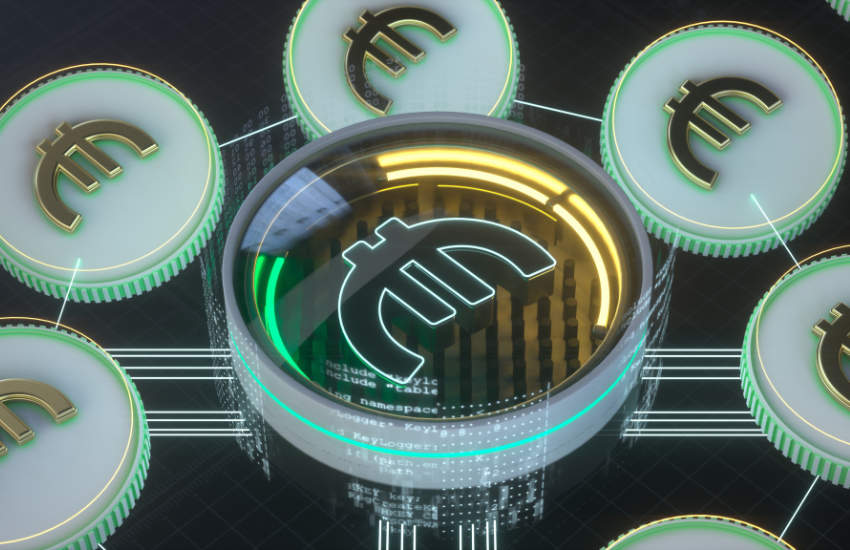Digital euro prototypes highlight offline challenges
Last week the European Central Bank (ECB) published the results of its first digital euro prototypes and a paper surveying suppliers of central bank digital currency (CBDC) technology. The first paper questioned whether technology would be available to support an offline digital euro within five to seven years at the levels it demands. It also shared details about the prototype N€XT backend system developed in-house by the ECB, which encountered some challenges.
In September last year, the central bank announced that it selected five organizations to carry out front end prototypes for different scenarios. For example, Amazon developed the user interface (UI) for e-commerce payments and Worldline for peer-to-peer offline payments. Subsequently, the ECB shared its high level design work for its prototype backend settlement engine. And it revealed more in the latest paper.
The prototypes are intended purely for learning rather than representing final choices. The paper mentions they will be discarded.
The N€XT digital euro ledger
The ECB’s N€XT settlement ledger that will process all digital euro transactions uses the UTXO unit (token) based model popularized by Bitcoin (see below account v token based). However, N€XT is not a distributed ledger. Notably, the survey of technology providers found that most offered token-based approaches. However, we wonder whether these responses might have been influenced by the knowledge that the ECB had adopted this approach in experiments.
One side effect of adopting a token-based approach is it will be more work and cost for most payment providers whose systems are set up for account-based systems.
Initially, N€XT was found to be linearly scalable as volumes increased. However, there were issues when there was a flood of transactions, which requires more time to explore.
Privacy benefits of tokens
A key advantage of the UTXO approach adopted by the ECB is privacy. With an account-based approach, each transaction an individual makes accumulates under that one identity. In contrast, the UTXO methodology means there are just tokens and transactions. The central bank does not need to be aware of which wallet holds the tokens and doesn’t even need the pseudonym of the token owner to process transactions.
This pushes work onto intermediaries who will have access to some of this private data and will have to monitor holding limits as the current thinking is a maximum of €3,000 per person. One issue not addressed is how this prevents users from having multiple accounts with different intermediaries. Theoretically, there would need to be a distributed ledger or centralized system to cross check identities and holdings.
Self custody and offline wallets
One of the experiments explored a custodied model and also one where keys that authorize transactions were stored in a self-custody wallet. The paper notes the benefit of “self- custody wallets, which could potentially allow for more privacy – pending legislative developments.”
Turning to the offline digital euro use case, the prototype used an account-based mechanism rather than token based and worked just fine. One challenge is Apple’s limitation of not allowing near field communications (NFC) for iPhone payments other than Apple Pay. While the report didn’t mention Apple, last year, the EU made a preliminary finding that this restriction puts Apple in breach of EU competition law.
A key challenge is developing a production grade offline solution within five to seven years. That’s partly because this is an emerging sector, so no mature software is available. There’s a lack of security standards that combines both hardware and software elements that offline CBDC requires. Perhaps the biggest is the rollout challenge, given an offline CBDC will need to be supported on all sorts of different devices and at points of sale.
Next steps for digital euro prototypes
Apart from the N€XT problems when flooded with transactions, the ECB is keen to investigate how the system will work in a geographically distributed manner. It also wants to explore other technology options for each element that was prototyped, which might result in a second round of prototypes. Cross currency support also needs exploring.
Footnote: Account v token based CBDC
When it comes to digital currency payment systems, one of the technical choices is to use token-based or accounts-based. Most bank accounts are account-based, and this is the more conventional path. However, physical cash is more similar to token-based, and Bitcoin popularized the UTXO model, which the ECB refers to as unit based. In other words, instead of having a running balance, like cash, you have coins and you exchange coins when you spend money and receive different coins in return. In theory, the coin you receive is not connected to the coin you gave (although it is with Bitcoin).
https://www.ledgerinsights.com/digital-euro-prototypes-offline-challenges/





























